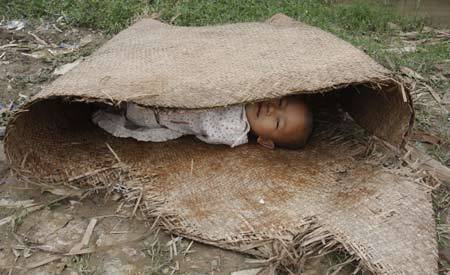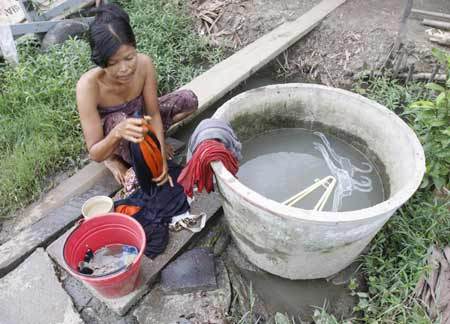The death toll from Cyclone Nargis has risen sharply to 77,738 in Myanmar, the state television reported in a night broadcast Friday, a fortnight after the disaster hit the country.

A child takes a nap by a road at a village hit by Cyclone Nargis, outside Yangon, May 16, 2008.
The dead included 159 state service personnel.
A total of 55,917 people, including 58 government employees remained missing, said the report.
The number of the injured stood at 19,359.
The sharp increase of the death toll was confirmed late because the disaster-hit area was so wide and the searching operation was hard that the authorities could not obtain the figures in time, the report clarified.
Myanmar government outlined a cyclone-relief policy shortly after the disaster, welcoming aid supplies from any country but denying entry for foreign aid workers to help launch rescue and relief operations, saying that it prefers to use its own strength.
The government also disallows foreigners to have access to disaster-hit areas, designating that relief activities including foreign, public and individual donations be handed over through the government's central relief and resettlement headquarters.
Meanwhile, the authorities claimed that the first phase of rescue of storm victims, provision of temporary shelter, supply of food and clothes and healthcare has been underway to an extent, while the present second phase sets domestic construction entrepreneurs to take part in the rehabilitation of the victims by promptly helping rebuild their respective wrecked houses in towns and villages mainly in Ayeyawaddy and Yangon divisions.
The third step is to re-generate farmlands which were flooded by sea water in the storm.
A deadly tropical cyclone Nargis, which occurred over the Bay of Bengal, hit five divisions and states -- Ayeyawaddy, Yangon, Bago, Mon and Kayin on May 2 and 3, of which Ayeyawaddy and Yangon inflicted the heaviest casualties and infrastructure damage.
Hard-hit coastal towns in the southwestern Ayeyawaddy division include Haing Gyi Island, Laputta, Mawlamyinegyun, Bogalay, Phyarpon, Kyaiklat, Ngaputaw, and Dedaye, while worst-hit areas in Yangon division comprised Kungyangon, Thanlyin, Kyauktan, Twantay, Kawmu as well as the Yangon city.

A woman washes clothes at her home at a village hit by Cyclone Nargis, outside Yangon, May 16, 2008.